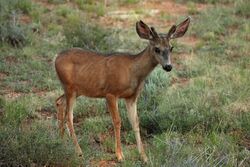Biology:Capreolinae
| Capreolinae Temporal range: Middle Miocene to present
| |
|---|---|

| |
| Mule deer (Odocoileus hemionus) | |
| Scientific classification | |
| Domain: | Eukaryota |
| Kingdom: | Animalia |
| Phylum: | Chordata |
| Class: | Mammalia |
| Order: | Artiodactyla |
| Family: | Cervidae |
| Subfamily: | Capreolinae Brookes, 1828 |
| Genera | |
| |
| Synonyms | |
|
Odocoileinae | |
The Capreolinae, Odocoileinae, or the New World deer are a subfamily of deer. Alternatively, they are known as the telemetacarpal deer, due to their bone structure being different from the plesiometacarpal deer subfamily Cervinae. The telemetacarpal deer maintain their distal lateral metacarpals, while the plesiometacarpal deer maintain only their proximal lateral metacarpals.[1] The Capreolinae are believed to have originated in the Middle Miocene, between 7.7 and 11.5 million years ago, in Central Asia.[2]
Although this subfamily is called New World deer in English, it includes reindeer, moose, and roe deer, all of which live in Eurasia in the Old World.
Classification
The following extant genera and species are recognized:[3][4][5][6][7]
- Tribe Capreolini
- Genus Capreolus
- Western roe deer (C. capreolus)
- Eastern roe deer (C. pygargus)
- Genus Hydropotes
- Water deer (H. inermis)
- Genus Capreolus
- Tribe Alceini
- Genus Alces
- Moose or Eurasian elk (A. alces)
- Genus Alces
- Tribe Odocoileini
- Genus Rangifer
- Caribou/reindeer (R. tarandus)
- Genus Odocoileus
- Mule deer (O. hemionus)
- White-tailed deer (O. virginianus)
- Yucatan brown brocket (O. pandora)
- †American mountain deer (O. lucasi)
- Genus Blastocerus
- Marsh deer (B. dichotomus)
- Genus Hippocamelus
- Taruca (H. antisensis)
- South Andean deer or huemul (H. bisulcus)
- Genus Mazama
- Gray brocket (M. gouazoubira)
- Northern Venezuelan brocket (M. cita, considered by some authorities to be a subspecies of M. gouazoubira)
- Ecuador brocket (M. murelia, considered by some authorities to be a subspecies of M. gouazoubira)
- Isla San Jose brocket (M. permira, considered by some authorities to be a subspecies of M. gouazoubira)
- Colombian brocket (M. sanctaemartae, considered by some authorities to be a subspecies of M. gouazoubira)
- Brazilian brocket (M. superciliaris, considered by some authorities to be a subspecies of M. gouazoubira)
- Peruvian brocket (M. tschudii, considered by some authorities to be a subspecies of M. gouazoubira)
- Rodon (M. rondoni, considered by some authorities to be a subspecies of M. gouazoubira)
- Amazonian brown brocket (M. nemorivaga)
- Central American red brocket (M. temama)
- Small red brocket or bororo (M. bororo)
- Dwarf brocket (M. chunyi)
- Pygmy brocket (M. nana)
- Merida brocket (M. bricenii)
- Little red brocket (M. rufina)
- American red brocket (M. americana) (This species has found to be closer to Odocoileus than other brockets.)[6]
- Ecuador red brocket (Mazama gualea, considered by some authorities to be a subspecies of M. americana)
- Brazilian red brocket (M. jucunda, considered by some authorities to be a subspecies of M. americana)
- Yucatan brown brocket (M. pandora)
- Trinidad red brocket (M. trinitatis, considered by some authorities to be a subspecies of M. americana)
- Southern red brocket (Mazama whitelyi, considered by some authorities to be a subspecies of M. americana)
- Peruvian red brocket (Mazama zamora, considered by some authorities to be a subspecies of M. americana)
- Colombian red brocket (Mazama zetta, considered by some authorities to be a subspecies of M. americana)
- Genus Ozotoceros
- Pampas deer (O. bezoarticus)
- Genus Pudu
- Northern pudu (P. mephistophiles)
- Southern pudu (P. pudu)
- Genus Rangifer
Extinct genera
- †Agalmaceros
- †Antifer
- †Bretzia
- †Cervalces
- †Eocoileus[citation needed]
- †Libralces
- †Morenelaphus
- †Pavlodaria[citation needed]
- †Procapreolus[citation needed]
- †Torontoceros
References
- ↑ Azanza, B.; Rossner, G.; Ortiz-Jaureguizar E. (2013). "The early Turolian (late Miocene) Cervidae (Artiodactyla, Mammalia) from the fossil site of Dron-Durkheim 1 (German) and implications on the origin of crown cervids". Palaeobiodiversity and Palaeoenvironments 93 (1): 217–258. doi:10.1007/s12549-013-0118-8.
- ↑ Gilbert, C.; Ropiquet, A.; Hassanin A. (July 2006). "Mitochondrial and nuclear phylogenies of Cervidae (Mammalia, Ruminantia): Systematics, morphology, and biogeography". Molecular Phylogenetics and Evolution 40 (1): 101–117. doi:10.1016/J.Ympev.2006.02.017. PMID 16584894.[yes|permanent dead link|dead link}}]
- ↑ Randi, E. et al. (February 2001). "A mitochondrial DNA control region phylogeny of the Cervinae: speciation in Cervus and implications for conservation". Animal Conservation 4 (1): 1–11. doi:10.1017/S1367943001001019.
- ↑ Pitraa, C. et al. (December 2004). "Evolution and phylogeny of old world deer". Molecular Phylogenetics and Evolution 33 (3): 880–895. doi:10.1016/j.ympev.2004.07.013. PMID 15522810.
- ↑ Alvarez D. (2007)[full citation needed]
- ↑ 6.0 6.1 Duarte, J.M.B.; González, S.; Maldonado, J.E. (October 2008). "The surprising evolutionary history of South American deer". Molecular Phylogenetics and Evolution 49 (1): 17–22. doi:10.1016/j.ympev.2008.07.009. PMID 18675919.
- ↑ "A new perspective on Ungulate Taxonomy". http://www.ultimateungulate.com/NewTaxonomy.html.
Wikidata ☰ Q118722 entry
 |

